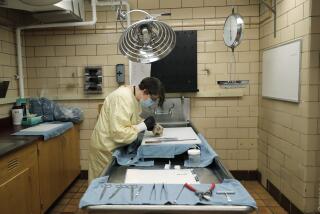Defused Virus Studied in Gene Therapy : Medicine: Test, which produced human protein in rats, shows promise in treating cystic fibrosis and inherited emphysema.
- Share via
Scientists using a defused common cold virus as a weapon have developed a new form of gene therapy that shows great promise for treating such lung disorders as cystic fibrosis and inherited emphysema, the two most common lethal inherited disorders among Caucasians.
The National Institutes of Health researchers, who performed the studies on rats, report in today’s issue of the journal Science that they inserted the gene for human lung proteins that are missing in the two disorders into a common cold virus that has a strong attraction for lung cells.
When the virus was sprayed into rats’ lungs, it was taken up by lung cells, which began producing the human protein.
“This is a first step, and a very important step, if we’re going to get to the point where we can do gene therapy for cystic fibrosis in humans,” said Robert Beall of the Cystic Fibrosis Foundation. “I feel that cystic fibrosis is clearly now at the top of the ladder for candidate diseases that can be treated by gene therapy.”
The proposed therapy must still undergo years of testing in monkeys and other animals to show that it will cause no harm, said molecular biologist Ronald G. Crystal of the National Heart, Lung and Blood Institute, leader of the team that conducted the research. Nonetheless, the therapy could be used in humans within this decade, he added.
About 33,000 Americans are known to have cystic fibrosis, with an additional 1,000 to 2,000 new cases--one in every 1,800 births--diagnosed each year. The disease is marked by a buildup of mucus in the lungs that impairs breathing and leaves the victim susceptible to respiratory infections. The disorder also impedes absorption of fats from the diet.
Most cystic fibrosis victims die before their 40th birthday.
Inherited emphysema affects as many as 40,000 Americans. It is caused by the lack of a protein, called alpha-one-antitrypsin or AAT, that protects the lungs from destruction by an enzyme made by white blood cells. An inborn lack of AAT accounts for about 2% of the 2 million U.S. cases of emphysema. The vast majority of cases are caused by smoking and are not inherited.
The defective gene in cystic fibrosis was discovered in August, 1989, and researchers earlier this year demonstrated that putting a healthy form of the gene into lung cells grown in a test tube could reverse the effects of the disease.
Gene therapy is highly experimental in humans. Only two groups of researchers, both at NIH, have been given permission to attempt it in treating melanoma, a deadly form of skin cancer, and in a rare hereditary disease that causes immune deficiency.
The new approach is a departure from the two major techniques that are most commonly proposed for human gene therapy. But neither of those techniques, scientists believe, can be effectively used for treating lung cells.
Crystal and his colleagues chose to work instead with adenoviruses, which normally cause colds. “Adenoviruses love the lung. They go in very easily,” he said.
Using the virus, the researchers removed the genes that produce cold symptoms and those that allow the virus to reproduce, then added the gene for AAT. When the lungs of rats were flushed with a solution containing the altered virus, it was taken up by lung cells, which began producing the human protein.
Although today’s paper deals only with AAT, Crystal said they have repeated the experiment with the CF gene and that the CF protein has been observed in the rats’ lungs for six weeks, the longest time they have studied it.
Because no animals actually are stricken with either AAT deficiency or cystic fibrosis, there is as yet no way to determine if the gene therapy will alleviate symptoms of the disease. But, he said, the previous experiments with cells grown in test tubes suggest that the therapy will be beneficial.
The biggest obstacle facing the researchers is proving that the treatment is safe. Potential problems include the possibility that the altered virus might infect cells elsewhere in the body, that it might exchange genetic information with other adenoviruses in the environment to produce adverse effects, and that it might interfere with the body’s immunity to adenoviruses.






